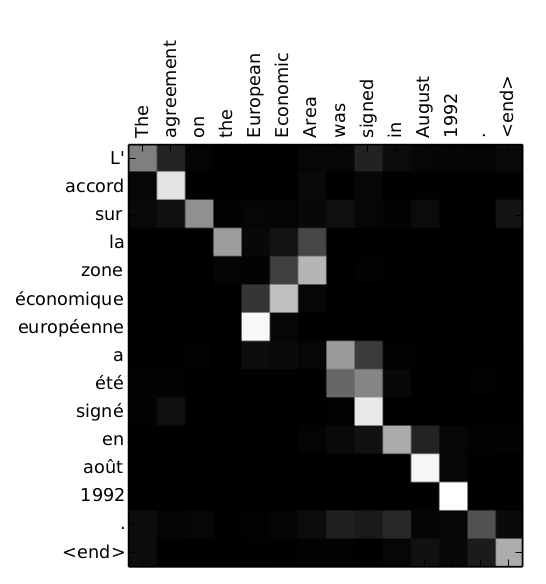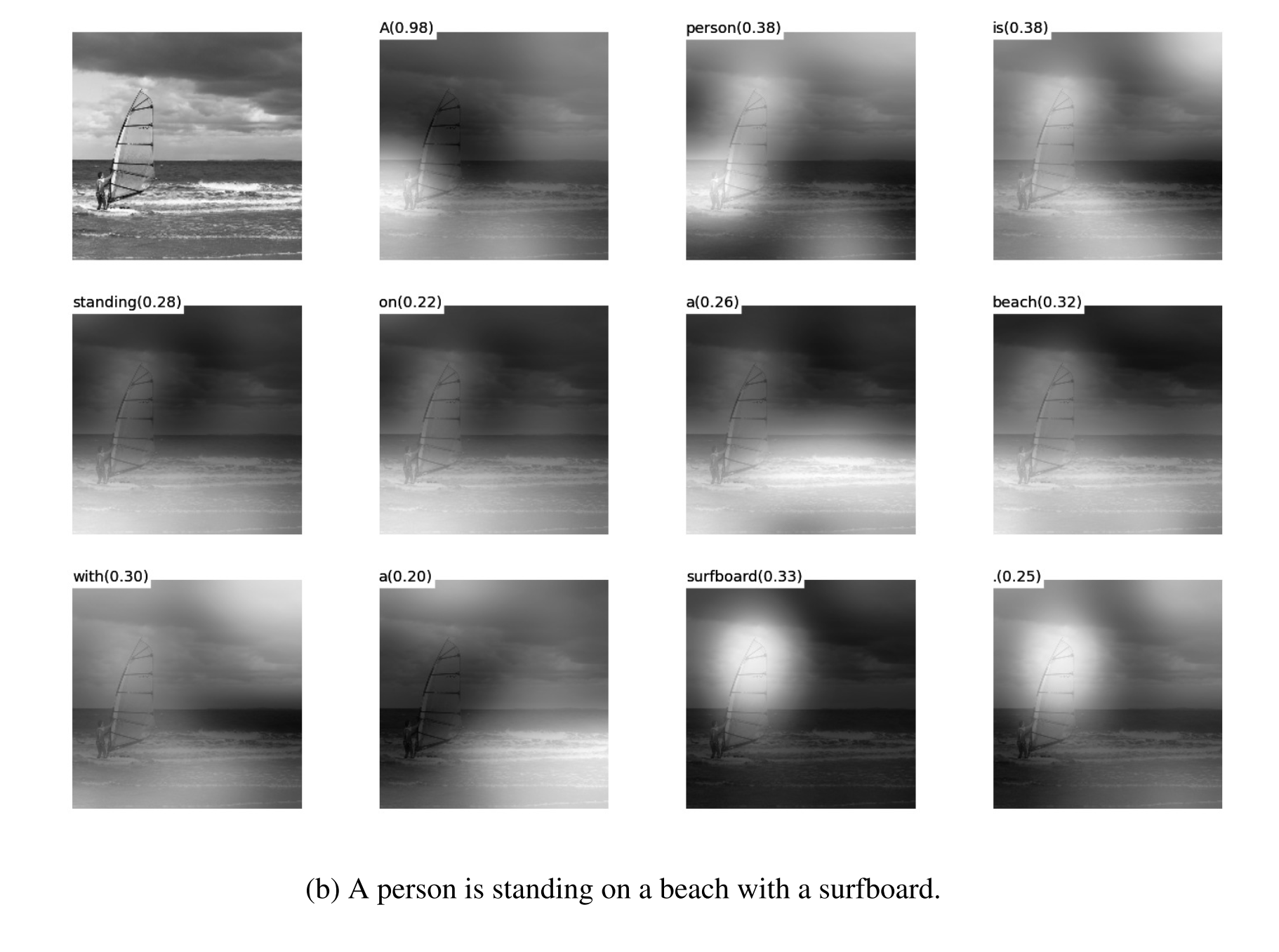Attention
CSE 891: Deep Learning
Vishnu Boddeti
Monday October 19, 2020
Today
- Attention
The Problem with Long Sequences





- Context vector $\mathbf{c}$ is often just $\mathbf{h}_T$
- Input sequence is bottlenecked through fixed-sized vector. What if $T=1000$?
Image Captioning with CNN and RNN

- Mao et al, "Explain Images with Multimodal Recurrent Neural Networks", NeurIPS 2014 Deep Learning and Representation Workshop
- Karpathy and Fei-Fei, "Deep Visual-Semantic Alignments for Generating Image Descriptions", CVPR 2015
- Vinyals et al, "Show and Tell: A Neural Image Caption Generator", CVPR 2015
- Donahue et al, "Long-term Recurrent Convolutional Networks for Visual Recognition and Description", CVPR 2015
- Chen and Zitnick, "Learning a Recurrent Visual Representation for Image Caption Generation", CVPR 2015
Image Captioning with CNN and RNN








How does it do?


What do we want?

Human Vision

Attention in Animals
- Resource Saving
- Only need sensors where relevant bits are (e.g. fovea vs. peripheral vision)
- Only compute relevant bits of information (e.g. fovea has many more ‘pixels’ than periphery)
- Variable State Manipulation
- Manipulate environment (for all grains do: eat)
- Learn modular subroutines (not state)
Regression

Watson Nadaraya Estimator (1964)
- Data $\{x_1,\dots,x_m\}$ and labels $\{y_1,\dots,y_m\}$.
- Estimate label $y$ at a new location $x$.
- The world's dumbest estimator: average over all labels $$\begin{equation} y = \frac{1}{m}\sum_{i=1}^m y_i \end{equation}$$
- Better Idea (Watson, Nadaraya, 1964)
- Weigh the labels according to location

- $\alpha(x,x_i)y_i$
- $x$: query
- $x_i$: key
- $y_i$: value
Weighing The Locations


Watson Nadaraya Estimator
- Consistency: Given enough data this algorithm converges to the optimal solution.
- Simplicity: No free parameters - information is in the data not weights (or very few if we try to learn the weighting function)
- Deep Learning Variant:
- Learn weighting function.
- Replace averaging (pooling) by weighted averaging.
General Attention Layer
 $$\begin{eqnarray}
&&\mathbf{z} = \sum_{i=1}^n \alpha(\mathbf{c},\mathbf{y}_i)\mathbf{y}_i \\
&&\alpha(\mathbf{c},\mathbf{y}_i) \geq 0 \\
&&\sum_{i=1}^n\alpha(\mathbf{c},\mathbf{y}_i) = 1
\end{eqnarray}$$
$$\begin{eqnarray}
&&\mathbf{z} = \sum_{i=1}^n \alpha(\mathbf{c},\mathbf{y}_i)\mathbf{y}_i \\
&&\alpha(\mathbf{c},\mathbf{y}_i) \geq 0 \\
&&\sum_{i=1}^n\alpha(\mathbf{c},\mathbf{y}_i) = 1
\end{eqnarray}$$
- Key-Value Store in associative memory (dictionary/has table/database).
- storing (saving)
- retreiving (querying)
- managing
- Keys, Queries and Values
- $\mathbf{c}$: query
- $\alpha(\mathbf{c},\mathbf{y}_i)$: key
- $\mathbf{y}$: values
Seq2Seq with RNNs and Attention








Seq2Seq with RNNs and Attention
- English: English to French translation
- Input:"This agreement on the European Economic Area was signed in August 1992."
- Output:L'ccord sur la zone économique européenne a été signé en août 1992.

Seq2Seq with RNNs and Attention
- The decoder doesn't use the fact that $\mathbf{h}_i$ form an ordered sequence – it just treats them as an unordered set $\{\mathbf{h}_i\}$
- Can use similar architecture given any set of input hidden vectors $\{\mathbf{h}_i\}$?
- Attention: Deep Learning on Sets

Image Captioning with Attention
- Use a CNN to compute a grid of features for an image.
- Each timestep of decoder uses a different context vector that looks at different parts of the input image
Image Captioning with Attention

- Xu et al, "Show, Attend, and Tell: Neural Image Caption Generation with Visual Attention", ICML 2015
X, Attend, and Y
- "Show, attend, and tell" (Xu et al, ICML 2015)
- Look at image, attend to image regions, produce question
- "Ask, attend, and answer" (Xu and Saenko, ECCV 2016)
- "Show, ask, attend, and answer" (Kazemi and Elqursh, 2017)
- Read text of question, attend to image regions, produce answer
- "Listen, attend, and spell" (Chan et al, ICASSP 2016)
- Process raw audio, aEend to audio regions while producing text
- "Listen, attend, and walk" (Mei et al, AAAI 2016)
- Process text, attend to text regions, output navigation commands
- "Listen, attend, and walk" (Mei et al, AAAI 2016)
- Process text, attend to text regions, output navigation commands
- "Show, attend, and interact" (Qureshi et al, ICRA 2017)
- Process image, attend to image regions, output robot control commands
- "Show, attend, and read" (Li et al, AAAI 2019)
- Process image, attend to image regions, output text
Attention Layer
- Inputs:
- Query Vector: $\mathbf{q} \in \mathbb{R}^{d}$
- Input Vector: $\mathbf{X} \in \mathbb{R}^{n \times d}$
- Similarity Function: $f_{att}(\cdot)$
- Computation:
- Similarities: $e_i=f_{att}(\mathbf{q},\mathbf{x}_i)$, $\mathbf{e}\in\mathbb{R}^{n}$
- Attention Weights: $\mathbf{a}=softmax(\mathbf{e})$, $\mathbf{a}\in\mathbb{R}^{n}$
- Output Vector: $\mathbf{y}=\sum_{i=1}^n a_i\mathbf{x}_i$, $\mathbf{y}\in\mathbb{R}^{d}$





Attention Layer Variations
- Similarity Functions:
- Dot Product: $f_{att}(\mathbf{q},\mathbf{x}_i) = \mathbf{q}^T\mathbf{x}_i$
- Scaled Dot Product: $f_{att}(\mathbf{q},\mathbf{x}_i) = \frac{\mathbf{q}^T\mathbf{x}_i}{\sqrt{d}}$
- Multiple Queries Product: $f_{att}(\mathbf{Q},\mathbf{X}) = \mathbf{Q}^T\mathbf{X}$
- Separate Key and Value
- $\mathbf{K} = \mathbf{W}_k\mathbf{X}$
- $\mathbf{V} = \mathbf{W}_v\mathbf{X}$
Common Attention Layer
- Inputs:
- Query Vector: $\mathbf{q} \in \mathbb{R}^{d}$
- Input Vector: $\mathbf{X} \in \mathbb{R}^{n \times d}$
- Similarity Function: $f_{att}(\cdot)$
- Computation:
- Keys: $\mathbf{K}=\mathbf{W}_k\mathbf{X}$
- Similarities: $\mathbf{E}=f_{att}(\mathbf{K},\mathbf{Q})$, $\mathbf{e}\in\mathbb{R}^{n\times n}$
- Attention Weights: $\mathbf{A}=softmax(\mathbf{E})$, $\mathbf{A}\in\mathbb{R}^{n \times n}$
- Values: $\mathbf{V}=\mathbf{W}_v\mathbf{X}$
- Output Vector: $\mathbf{y}_j=\sum_{i=1}^n A_{ij}\mathbf{v}_i$, $\mathbf{y}\in\mathbb{R}^{d}$






Hard Attention Layer
- Inputs:
- Query Vector: $\mathbf{q} \in \mathbb{R}^{d}$
- Input Vector: $\mathbf{X} \in \mathbb{R}^{n \times d}$
- Similarity Function: $f_{att}(\mathbf{q},\mathbf{x}_i) = \frac{\mathbf{q}^T\mathbf{x}_i}{\sqrt{d}}$
- Computation:
- Similarities: $e_i=f_{att}(\mathbf{q},\mathbf{x}_i)$, $\mathbf{e}\in\mathbb{R}^{n}$
- Attention Weights: $\mathbf{a}=softmax(\mathbf{e})$, $\mathbf{a}\in\mathbb{R}^{n}$
- Output Vector: $\mathbf{y}=sample(\mathbf{x};\mathbf{a})$, $\mathbf{y}\in\mathbb{R}^{d}$
Self-Attention Layer
- One query per input
- Inputs:
- Query Vector: $\mathbf{X} \in \mathbb{R}^{n\times d}$
- Input Vector: $\mathbf{X} \in \mathbb{R}^{n \times d}$
- Similarity Function: $f_{att}(\mathbf{q},\mathbf{x}_i) = \frac{\mathbf{q}^T\mathbf{x}_i}{\sqrt{d}}$
- Computation:
- Keys and Queries: $\mathbf{K}=\mathbf{W}_k\mathbf{X}$, $\mathbf{Q}=\mathbf{W}_q\mathbf{X}$
- Similarities: $\mathbf{E}=f_{att}(\mathbf{K},\mathbf{Q})$, $\mathbf{e}\in\mathbb{R}^{n\times n}$
- Attention Weights: $\mathbf{A}=softmax(\mathbf{E})$, $\mathbf{A}\in\mathbb{R}^{n \times n}$
- Values: $\mathbf{V}=\mathbf{W}_v\mathbf{X}$
- Output Vector: $\mathbf{y}_j=\sum_{i=1}^n A_{ij}\mathbf{v}_i$, $\mathbf{y}\in\mathbb{R}^{d}$






Self-Attention Layer
- Consider permuting the vectors
- Queries and Keys will be the same, but permuted
- Similarities will be the same, but permuted
- Attention will be the same, but permuted
- Values will be the same, but permuted
- Outputs will be the same, but permuted
- Self-Attention layer is Permutation Equivariant $f(s(x)) = s(f(x))$
- Self-Attention layer works on sets of vectors






Masked-Attention Layer
- One query per input
- Inputs:
- Query Vector: $\mathbf{X} \in \mathbb{R}^{n\times d}$
- Input Vector: $\mathbf{X} \in \mathbb{R}^{n \times d}$
- Similarity Function: $f_{att}(\mathbf{q},\mathbf{x}_i) = \frac{\mathbf{q}^T\mathbf{x}_i}{\sqrt{d}}$
- Computation:
- Keys and Queries: $\mathbf{K}=\mathbf{W}_k\mathbf{X}$, $\mathbf{Q}=\mathbf{W}_q\mathbf{X}$
- Similarities: $\mathbf{E}=f_{att}(\mathbf{K},\mathbf{Q})$, $\mathbf{e}\in\mathbb{R}^{n\times n}$
- Set future similarity to $-\infty$
- Attention Weights: $\mathbf{A}=softmax(\mathbf{E})$, $\mathbf{A}\in\mathbb{R}^{n \times n}$
- Values: $\mathbf{V}=\mathbf{W}_v\mathbf{X}$
- Output Vector: $\mathbf{y}_j=\sum_{i=1}^n A_{ij}\mathbf{v}_i$, $\mathbf{y}\in\mathbb{R}^{d}$






Example: CNN with Self-Attention

Processing Sequences
RNN
- Works on Ordered Sequences
- Good at long sequences: After one RNN layer, $h_T$ "see" the whole sequence
- Not parallelizable: need to compute hidden states sequentially
CNN
- Works on Multidimensional Grids
- Bad at long sequences: Need to stack many conv layers for outputs to "see" the whole sequence
- Highly parallel: Each output can be computed in parallel
Self-Attention
- Works on Sets of Vectors
- Good at long sequences: after one self-attention layer, each output "sees" all inputs
- Highly parallel: Each output can be computed in parallel
- Very memory intensive
Summary
- Adding "attention" to RNN models lets them look at different parts of the input at each timestep
- Generalized Self-Attention is new, powerful neural network primitive
- Lot more in next class